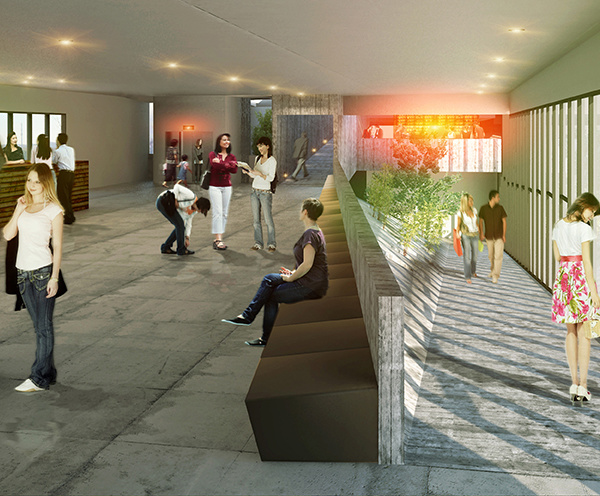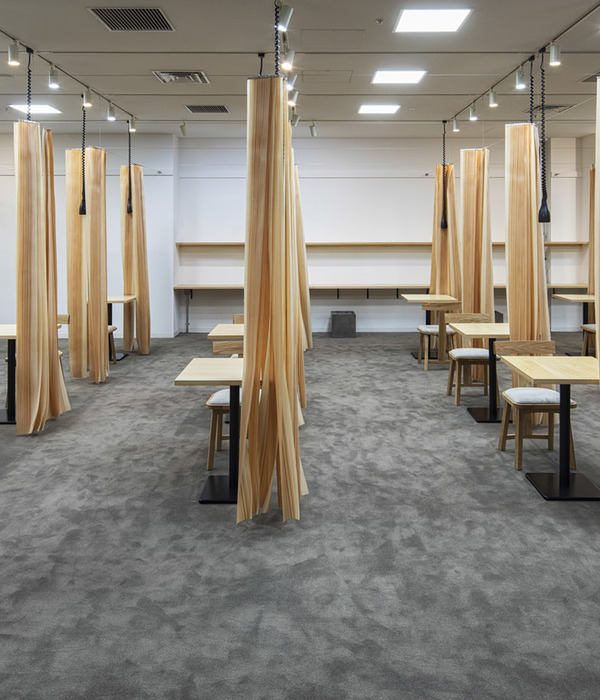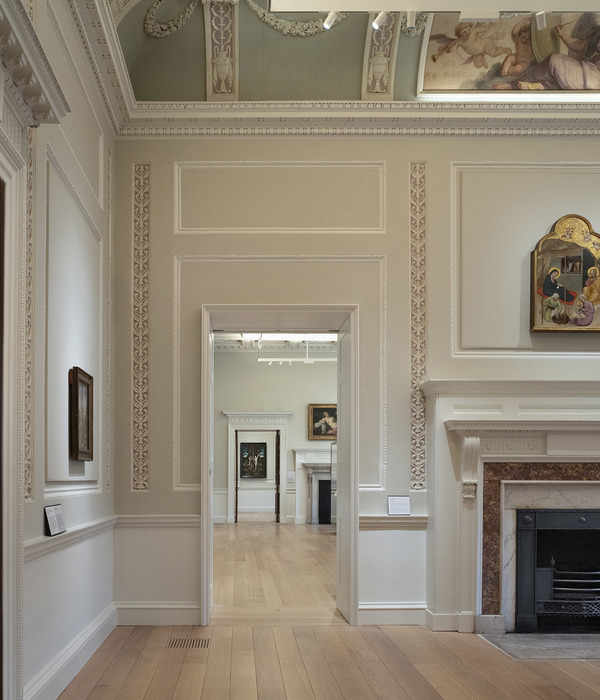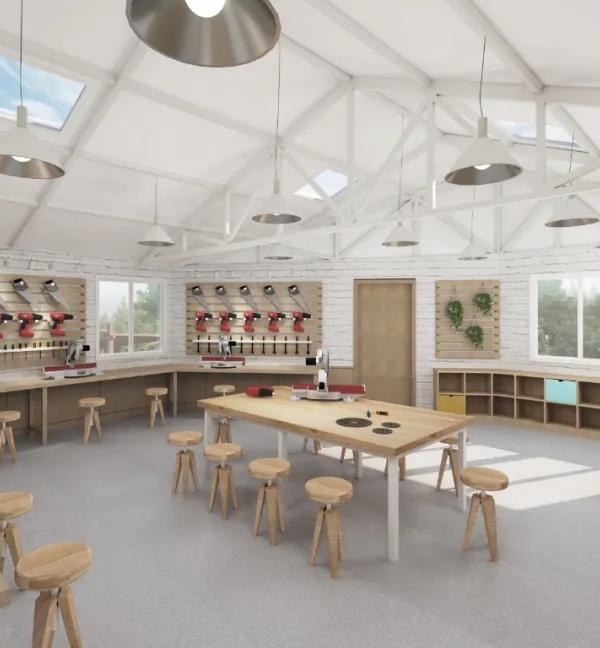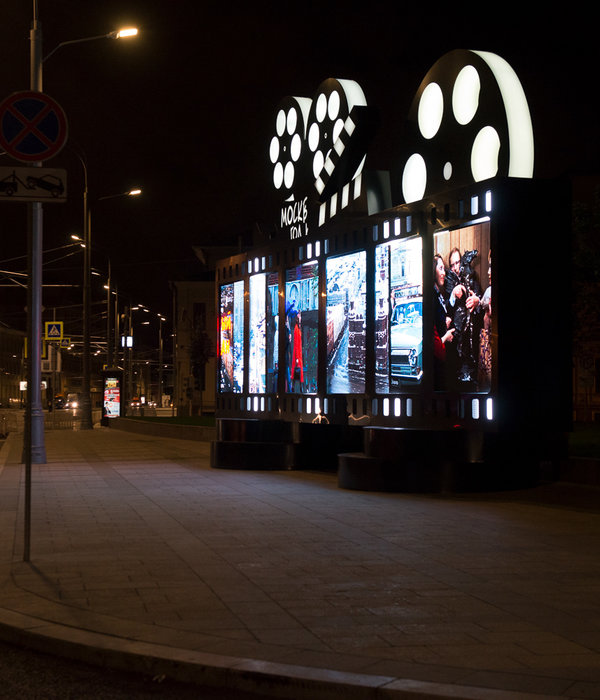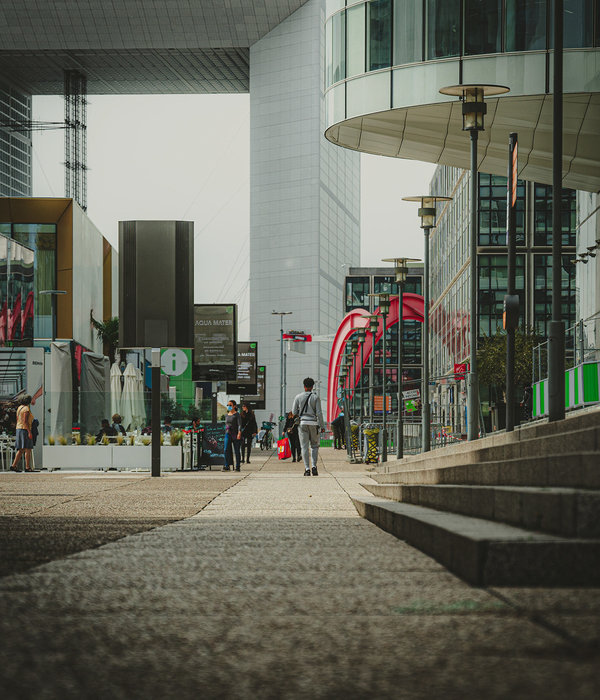- 项目名称:博世汽车部件(苏州)停车楼一期
- 设计方:中衡设计集团
- 主创建筑师:刘恬,赵海峰
- 建筑:徐轶群,魏之豪
- 结构:路江龙,沈晓明,杨伟兴,王俊杰,白瑞芳
- 景观:胡砚,张骏腾,陈雨菲,高霞
- 电气:韩愚拙,徐宽帝
- 暖通:朱勇军,嵇素雯
- 给排水:杨俊晨,郁捷
- 项目地址:苏州
- 建筑面积:74295.74 m2
- 摄影版权:秦伟
- 客户:博世汽车部件(苏州)有限公司
- 品牌:停车场专用树脂混凝土成品排水系统,ENF系列树脂混凝土成品排水系统
自1909年进入中国市场以来,我国已成为博世集团(BOSCH)除德国外拥有员工人数最多的国家。本项目为博世汽车部件(苏州)有限公司厂区内的第二座开敞式停车楼设计。由于产业类型有首层重荷载需求,地下空间不宜利用,多层停车楼成为更为经济合理的选择。本项目共6层,首层占地面积约5120m2,总建筑面积约30653 m2,总停车数量约为990个。
Since its entry into the Chinese market in 1909, Bosch Group (BOSCH) has become the largest employer outside of Germany. This project involves the design of the second open parking garage within the Bosch Automotive Products (Suzhou) Co., Ltd. plant area. Due to the heavy load requirements of the first floor and the unsuitability of underground space utilization, a multi-story parking garage became the more economically reasonable choice. The project consists of six floors, with the first floor covering an area of approximately 5120 m2, and a total building area of approximately 30653 m2, accommodating a total of approximately 990 parking spaces.
▼ 整体鸟瞰,overall bird’s eye view
在业主方设计部门的技术指导、使用方的经费支持和现场管理部门的协同控制下,我们得以将装配式设计理念贯彻始终,并以较高的项目完成度呈现出功能理性与技术美学的统一。
With technical guidance from Bosch’s design department and coordinated control from the on-site management department, we successfully implemented a prefabricated design concept throughout the project. This allowed us to achieve a high level of project completion with a unified functional rationality and technical aesthetics.
▼ 城市立面的立体绿化 ,three-dimensional greening of urban facades
01
纯粹性与复杂性:功能-平面-构造
Purity and Complexity: Function-Plan-Tectonics
由于简单的建筑形式降低了设计的容错率,建筑完成品质的控制成为本项目的难点。干净的平面布局和清晰的结构逻辑背后是精细的平面控制和特殊的构造节点处理。
Ensuring the building quality was a significant challenge for this project, primarily due to the streamlined architectural form that left little room for design errors. While the plan layout appeared straightforward, meticulous plan control and specialized tectonic node design were crucial in achieving the final result. The building’s structural logic was clear, but behind it lay a careful attention to detail in every aspect of the design process.
▼ 场地环境:停车楼与厂区、道路的空间关系,the overall setting: the spatial relationship between the parking building, the factory and the roads
(1)立体分流、隐私控制。本项目在功能要求上需停放大巴和小汽车两种类型,其中小汽车又分为外部访客车和内部概念测试车两个区域。作为工业厂区内的民用建筑,建筑师需要在有限空间中最大限度地利用土地,并保证各类汽车车行流线的通畅和独立。大巴与厂区货车错峰共用出入口,统一停放于一层;员工和访客小汽车出入口直接开向城市道路,由两座悬挑的螺旋形坡道引至停车楼三层以上区域,造型颇具雕塑美感;测试车因均为外观保密的概念车,为防止泄密需单独的车行流线,在侧面另设直行坡道与厂区直接连接,并将变电所、机房等设备用房控制在坡道下,以获得干净的平面布局。
Three-dimensional diversion and privacy control measures. The project involves parking for both buses and cars, including external visitors’ cars and internal concept testing ones, making it essential to ensure the smooth and independent flow of various types of vehicle traffic. As a civil building within an industrial plant, the architect faced the challenge of maximizing land use within limited space while also implementing three-dimensional diversion and privacy control measures. The first floor of the parking garage is reserved for buses and plant trucks, with separate entrances and exits that are arranged in a staggered manner. On the other hand, employee and visitor cars have entrances and exits that directly open onto the city’s roads. To accommodate different traffic flows, two cantilevered spiral ramps were designed to direct cars to the parking areas on the third floor or above, with a sculptural aesthetic. For the concept testing cars, which have confidential designs, a separate traffic flow line was created to prevent information leaks. A straight ramp was set up on the side to connect directly to the plant area, with equipment rooms such as substations and machine rooms arranged below the ramp to ensure a clean plan layout.
▼螺旋形坡道与主体建筑的关系,the relationship between the spiral ramp and the main building
(2) 特殊的构造节点处理。本项目采取了钢结构为主、混凝土为辅的混合结构,结构逻辑清晰但技术难度不小。在混凝土螺旋坡道部分,建筑师与结构工程师合作将边梁做了特殊的技术处理,以获得纯净的形式。在主体部分混凝土柱和钢结构梁的连接节点构造设计方面,建筑师提前从功能使用和形式美学两方面进行了复杂的管线综合设计,并在钢结构梁上预留出洞口,以获得更为纯粹的空间。
The specialized tectonic node processing. The mixed structure, primarily composed of steel and reinforced concrete, presents significant technical difficulties, which require clear structural logic and specialized treatments. For instance, in the concrete spiral ramp section, the edge beams underwent special technical treatment to achieve a pure form. Additionally, in the main section, the architect integrated complex pipelines from both functional usage and aesthetic form perspectives before the construction of the connection nodes between the concrete columns and steel beams. Finally, the architect also reserved holes on the steel beams to create a more pure space. Overall, these specialized tectonic node processing techniques were necessary to ensure a high degree of project completion and technical aesthetics.
▼螺旋坡道边梁的特殊技术处理,the special technical treatment of the edge beams
▼特殊的构造节点处理,specialized tectonic node design
02
标准化与精细度:装配式设计理念的贯彻
Standardization and Precision: Implementation of the Prefabricated Design Concept
由于一层以上的每个楼层的平面布局除坡道外排布完全一致,建筑师与业主设计部在项目伊始共同商讨,确定执行装配式设计理念。首先,选择合理经济且均等的柱跨,从而使每层和每跨内的建筑构件、结构构件、机电吊架与综合管线等均能按照模数标准化设计;
其次,精细化的设计,以保证施工实施的准确性。建筑师提前考虑了精确的深化细节,提供了预制花槽、楼层钢梁、柱头节点、楼面压型钢板等所有预制构件的设计详图。根据《江苏省装配式建筑综合评定标准》,本项目基本单元、构件标准化率达到100%;标准化预制构件应用比例达到95%。
To achieve standardization and improve construction accuracy, the architect and client’s design department opted for a reasonable and cost-effective column span, allowing building and structural components, mechanical and electrical suspensions, and pipelines to be designed according to modular standards for each floor and span. The architect also provided detailed drawings of prefabricated components such as flower grooves, floor steel beams, column head nodes, and pressure-formed steel plates to ensure accuracy during construction. The project achieved a standardization rate of 100% for basic units and components, with 95% of standardized prefabricated components used, as per the “Comprehensive Evaluation Standard for Prefabricated Buildings in Jiangsu Province.”
▼顶层的太阳能板,solar panels on the top floor
对细节的专注是保证装配式项目完成度和统一性的基石。以停车楼内部的标识设计为例,将品牌色提炼为标识系统的主色调以突出企业特色、挑选字体形态以呼应扁平的空间形态,以及定制浅灰色的水马围挡以符合建筑整体风格等,建筑师对设计细节的精细控制,保证了项目效果的整体性和连贯性。
Paying attention to details is crucial to ensure the successful implementation and consistency of prefabricated projects. To illustrate, the architect of the parking garage project meticulously designed the interior signage system, selecting the company’s brand color as the main tone to showcase its identity, choosing font styles that match the flat spatial form, and customizing light gray water safety barriers that complement the building’s overall style. By meticulously controlling the design details, the architect was able to achieve a cohesive and harmonious outcome for the project.
▼企业品牌色的提炼与衔接(剖面图)The company’s brand color as the main tone of signage system
▼螺旋形坡道上的标识系统,signage system on spiral ramps
03
开敞式与季相性:立面植物造景
Openness & Seasonal Phenomena: Creating Urban Landscape with Facade Plants
综合考虑功能合理化和造价经济化的要求,开敞式是停车楼最适宜的选择。同时,由于选址位于厂区边缘与城市道路交界处,出于美化城市界面的考虑,深化设计延续了老停车楼的设计策略(植物为爬山虎),立体绿化成为本项目的立面特色。
To ensure functional rationalization and cost-effectiveness, an open design was chosen for the parking building, which is located at the intersection of the factory and urban roads. In addition to meeting these requirements, the architects also aimed to beautify the urban interface, continuing the design strategy of the old parking building (using ivy plants) by incorporating three-dimensional greening into the facade of the new building.
▼厂区内植物生长茂盛的建于2010年的老停车楼,old parking building using ivy plants built in 2010
“凡四时之气,各置一境以领之”,苏州园林的营造不仅注重空间性,时序性的景观营造更是别具一格。本项目中,建筑师巧妙地借鉴苏州园林中“四时之景”的独特营造理念,通过立面植物造景赋予了建筑时令感。“季相”即植物群落的季节性外貌。因此,在立体绿化的植物选择上,在常规的爬山虎(秋)之外,建筑师还精心挑选了具有季节特色的藤本植物,如紫藤、迎春花(春)、凌霄花(夏)等需要一定成长周期的植物以平衡植物的生长与对建筑功能的干扰,栽种于悬挑的预制花槽中,并设计以热镀锌钢丝拉索方便植物爬藤;而则被考虑放置于首层,以发挥植物的“绿篱”作用。
The principle of “creating a different landscape to represent four seasons separately,” which is a fundamental concept in traditional Suzhou garden design, not only emphasizes the construction of spatial landscapes but also highlights the importance of seasonal landscapes. In this project, the architects creatively incorporated the concept of “four-season views” from Suzhou gardens to the design of the building’s facade greenery, giving it a sense of seasonality. “Seasonal phenomena” refers to the seasonal appearance of plant communities. In addition to the common ivy,to ensure the plants in the three-dimensional greening are compatible with the seasons, the architects chose climbing plants that are appropriate for different seasons, such as wisteria and winter jasmine for spring and sky vine for summer. These plants were selected based on their growth cycle, to ensure they don’t interfere with the building’s functions. They were planted in prefabricated flower grooves that were designed with hot-dip galvanized steel wire ropes for easy plant climbing. The yucca gloriosa(凤尾丝兰) was also included on the ground floor as a “green fence”.
▼季相性的立面,the seasonal appearance of facade
▼预制花槽与热镀锌钢丝拉索,prefabricated flower grooves
▼预制花槽详图,detail of the prefabricated flower grooves
错开层高线布置的预制花槽,在深色的建筑画布上勾勒出随四季变化的植物色块, “四时之景”为城市街景贡献了具有几何美感的“动态图画”。
The flower grooves were arranged at different heights on the facade to create a changing plant display throughout the four seasons. This created a geometrically beautiful “dynamic painting” of “four-season views” that contributed to the urban landscape.
▼采用预制花槽的城市立面(选择了需要一定成长周期的植物),the flower grooves were arranged at different heights on the facade to create a changing plant display
▼总平面图,site plan
▼一层平面图,1st floor plan
▼二层平面图,2nd floor plan
▼三至六层平面图,3-6F plan
▼屋顶层平面图,roof floor plan
▼立面图,elevations
项目名称: 博世汽车部件(苏州)停车楼一期
设计方: 中衡设计集团
公司网站:
项目设计 & 完成年份: 2018&2019
主创建筑师: 刘恬、赵海峰
设计团队完整名单:
建筑:徐轶群、魏之豪
结构:路江龙、沈晓明、杨伟兴、王俊杰、白瑞芳
景观:胡砚、张骏腾、陈雨菲、高霞
电气:韩愚拙、徐宽帝
暖通:朱勇军、嵇素雯
给排水:杨俊晨、郁捷
项目地址: 苏州
建筑面积: 74295.74 m2
摄影版权: 秦伟
客户: 博世汽车部件(苏州)有限公司
品牌:停车场专用树脂混凝土成品排水系统、ENF系列树脂混凝土成品排水系统
Project name: BOSCH Szh215 Parking House Design (Phase I)
Design: ARTS Group Co., Ltd.
Website:
Design year & Completion Year: 2018&2019
Main architects: Liu Tian, Zhao Haifeng
Full list of design team:
Architecture: Xu Yiqun, Wei Zhihao
Structure: Lu Jianglong, Shen Xiaoming, Yang Weixing, Wang Junjie, Bai Ruifang
Landscape: Hu Yan, Zhang Junteng, Chen Yufei, Gao Xia
Electric: Han Yuhui, Xu Kuandi
HVAC: Zhu Yongjun, Ji Suwen
Water supply and drainage: Yang Junchen, Yu Jie
Gross Built Area : 74295.74 m2
Photo credits: QIN Wei
Clients:Bosch Automotive Products (Suzhou) Co., Ltd.
Brands: MEA®DRAIN, PG1500*500m, ENF2000
{{item.text_origin}}

